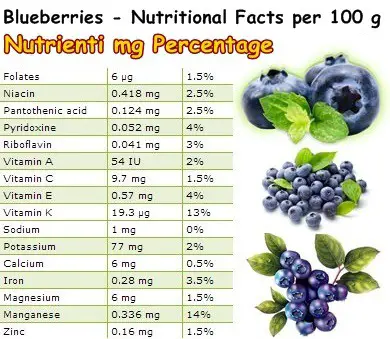Over the past few years people have started to take great interest in the amazing properties and uses of blueberries (Vaccinium sect. Cyanococcus).
Despite a modest nutritional value, blueberries have become popular thanks to their generous antioxidant content, a source of wonderful health benefits and long-term provider of good health.
Blueberries contain generous amounts of purple and blue-black anthocyanin antioxidants as well as good amounts of vitamins C, K and the antioxidant manganese, dietary fiber and are low in calories. Regular consumption can provide benefits for bones, the nervous, gastrointestinal and immune systems, skin and vision.

Types of blueberry
Most of the blueberry varieties available for purchase come from North America, the US and Canada, South America, Europe, Australia and New Zealand where they are grown commercially from a single variety occurring naturally in certain parts of North America and some its hybrids. The variety is called the northern highbush blueberry (Vaccinium corymbosum) and is the main cultivated blueberry variety.
The northern highbush blueberry occurs naturally in eastern Canada, eastern and southern US and has been naturalized across South America, Europe, Asia, New Zealand and other parts of the world.
Hybrid blueberry varieties resulting from the crossing of the northern highbush blueberry (Vaccinium corymbosum) and the southern lowbush blueberry (Vaccinium darrowii) also account for a significant part of the blueberry market worldwide.
Semi-wild and wild blueberries also account for a good deal of the blueberry supply in local markets. In Europe and Asia, for example, a significant part of of blueberries available in farmer’s markets, health food stores and mini-markets are sourced from the wild. And they are different varieties from the North American Vaccinium corymbosum blueberry and its hybrids.
The European blueberry, also called the bilberry (Vaccinium myrtillus), is a species of blueberry related to the American blueberry. The very-similar looking shrub grows freely in the wild throughout all of Europe and parts of Asia and bears fruits that look a lot like American blueberries. The fruits of the European blueberry are also blueberries.
Another popular type of blueberry is the bog blueberry or the bog bilberry (Vaccinium uliginosum). This type of blueberry is a common presence in the Northern hemisphere where is grows freely in the wild. The bog blueberry or bog bilberry is especially popular in Russia and colder regions of Europe where it represents the standard blueberry.
Blueberry vs bilberry vs bog blueberries
There are two main types of blueberry: the American blueberry and the European blueberry or the bilberry. While related and very similar looking, the two varieties are distinct species of the same fruit.
The first major difference between the two types of blueberry is the color of their flesh. That is, North American blueberries are pale white to greenish-white inside, with translucent flesh, and have several tiny light brown seeds while European blueberries, or bilberries, have a deeply pigmented dark red-purple flesh and slightly larger seeds.
Because their flesh is extremely pigmented, European blueberries (bilberries) stain more than blueberries – they will stain both skin and clothes. Because of their deep reddish purple flesh color, European blueberries are also much more flavorful. The natural pigments that color the flesh are called anthocyanins and are a source of rich tangy and fruity flavors that contribute to the taste of the fruit.
Another major difference between the two is that North American blueberries have a small protuberance at the end opposite to the stalk – the protuberance looks like a crown or five pointed-star and is made up of botanical sepals. By comparison, European blueberries or bilberries have a round depression at the end opposite to the stalk and look sunken in.
Lastly, American blueberries typically grow in clusters vs European bilberries which grow as singular fruits or in pairs, depending on the variety.
Bog blueberries are more similar to North American blueberries, with a star-shaped protuberance, blue-black skin, whitish, translucent flesh and sweet, but not too strong a flavor.

Blueberry nutrition facts
What vitamins and minerals do blueberries have?
Blueberries have a modest nutritional value and are highest in vitamins C and K and manganese. The berries have a good content of vitamins C (9.7 milligrams per 100 grams of fruit), K (19.3 micrograms per 100 grams) and manganese (0.336 milligrams per 100 grams). A serving of 100 grams of fresh blueberries provides 12%, 18% and 16% of the recommended daily intakes of vitamins C, K and manganese (average values for an adult).
Blueberries also contain smaller amounts of B vitamins (B1, B2, B3, B5, B6 and B9), vitamin E, calcium, iron, magnesium, phosphorus, potassium and zinc (less than 5% of the recommended daily allowance) and trace amounts of vitamin A. The nutrient that stands out the most in the entire nutrition profile of blueberries is vitamin K, followed by manganese and then vitamin C.
see also: Do Blueberries Have Seeds?
Other nutrients in 100 grams of fresh blueberries
- Dietary fiber: 2.4 grams of fiber per 100 grams of fresh blueberries
- Carbohydrates: 14.49 grams
- Sugars: 9.96 grams
- Fat: less than 0.4% (an almost irrelevant amount)
- Protein: less than 0.8 grams
- Water: 84 grams
- Energetic value: 57 kcal (kilocalories, calories) for every 100 grams of the fresh berries
What are the benefits of blueberries?
Antibleeding effects – good for blood coagulation
Vitamin K is essential for proper blood coagulation and a sufficient intake can help prevent hemorrhage, nosebleeds and easy bruising. Unless you have a predisposition for blood clots and are receiving anticoagulant medication as treatment, eating blueberries and leafy greens rich in vitamin K is good for you. Even then, limited intakes are typically well tolerated, without side effects.
Regulate calcium absorption for good bone density
The good content of vitamin K in blueberries helps with building strong, healthy bones and teeth. Vitamin K regulates calcium absorption in bones with positive effects on bone density. How? Vitamin K in the fruit is essential for the synthesis of a bone-related protein-hormone that is vital for binding calcium in bones and strengthening bone tissue.
The vitamin is also currently being researched for its potential applications in neurodegenerative diseases of the nervous system such as Alzheimer’s and Parkinson’s disease.
Anti-inflammatory benefits and immune-boosting action
Vitamin C in blueberries has amazing antioxidant, anti-inflammatory and antimicrobial properties. Vitamin C is scientifically proven to lower levels of inflammatory markers such as C-reactive protein and reduce inflammation in the body as well as modulates and boosts the immune system. Vitamin K helps reduce inflammatory cytokine interleukin-6 levels, while other antioxidants in the berries exert additional anti-inflammatory properties.
Eating blueberries can represent a source of benefits for inflammatory conditions like rheumatoid arthritis and offer a certain degree of pain relief. Although found in trace amounts in the fruit, zinc remains a great immune system booster and eating blueberries contributes towards daily values of the mineral.
Good for constipation and hemorrhoids
Blueberries have 2.4 grams of dietary fiber per 100 grams of fruit, most of which is located in the skin. Regular consumption helps relieve constipation naturally by adding bulk to stools and stimulating peristalsis consisting of contractions of the intestinal tract muscles that move food along. Constipation relief is also good for anyone with hemorrhoids, reducing frequency of flareups and helping manage symptoms.
Read more about what foods to eat and to avoid for hemorrhoids.

Contain B vitamins for energy metabolism
The B-group vitamins in the berries ensure the proper distribution of energy from carbohydrates, fats and protein synthesis. By processing macronutrients from food and contributing to energy metabolism, B vitamins combat fatigue.
Blueberries are also a good source of natural sugars which further provide quick energy for the body to use, making them a great food to eat for low blood sugar levels. How much sugar in blueberries? A serving of 100 grams of the fresh fruit has 9.96 grams of sugar.
Provide cardiovascular support
The good energetic value of blueberries (57 kcal per 100 grams) and fiber content (2.4 grams of dietary fiber for every 100 grams of fruit) contribute to weight management which is important for cardiovascular health, with long-term benefits.
The berries further provide very small amounts of vitamin B6 (0.052 milligrams), magnesium (6 milligrams) and potassium (77 milligrams), three key nutrients for good cardiovascular health. Potassium has electrolyte properties and regulates blood pressure numbers by adjusting levels of fluid in the body and neutralizing the side effects of excess sodium.
Magnesium and vitamin B6 support the activity of the heart muscle, with magnesium helping regulate contractions of the heart for anti-arrhythmia benefits. The average adult needs 1.7 milligrams of vitamin B6, 420 milligrams of magnesium and 4700 milligrams of potassium a day, every day, so blueberries contribute to daily values only modestly.
Benefits for high cholesterol and high blood pressure
Studies reveal eating blueberries is good for cardiovascular health. More exactly, the antioxidants responsible for the color of ripe blueberries may help lower levels of triglycerides in the blood as well as LDL (bad) cholesterol levels.
In instances of high blood pressure, blueberries can help reduce both systolic and diastolic blood pressure for better blood pressure control, a benefit attributable to pigmented antioxidants and a good content of dietary fiber rather than essential vitamins and minerals.
Vitamin K in the berries further contributes to cardiovascular health. The vitamin is involved in maintaining normal calcium metabolism and exerts anti-inflammatory effects with an anti-atherosclerotic action. Vitamin K essentially prevents abnormal plaque deposits on the inside of artery walls and atherosclerosis.
Blueberries for diabetes
Despite their relatively high sugar content (9.96 grams of sugar per 100 grams of fruit), blueberries have a low glycemic index (less than 55) which makes them a good good to eat with diabetes. Having a low glycemic index means that blueberries raise blood sugar levels slowly and steadily which is what makes them a safe food to eat for diabetics.
Additionally, research suggests pre-diabetics (people with consistently high blood sugar levels) may benefit from eating blueberries and enjoy improved insulin sensitivity as a result of regular consumption.
Another reason blueberries are good for diabetes is they help with weight management. Blueberries are moderately low in calories and have almost no fat which makes them a good food for weight loss. Excess weight is a risk factor for type 2 diabetes and losing weight, especially belly fat, helps lower risks as well as reverse the condition.
Observations
Prevention and management of diabetes type 2 requires more than just eating one good food – one food will not offset the effects of all the bad foods in your diet. It’s actually more important to watch your diet as a whole and try to eat clean on a daily basis, in accordance to your energy requirements.
With respect to how much blueberries diabetics can eat, it’s best to consult your doctor and find out what is a good amount for you specifically. Remember: blueberries still have quite a lot of sugar and, even though it’s absorbed steadily and does not cause spikes in blood sugar levels, there is a limit to how much of the berries you can eat in a day. Just as important, it’s recommended to eat blueberries raw and avoid adding sugar to them.
Below is a detailed video from the University of Maine showing proper pruning and care tips for blueberry shrubs. The video shows how to prune old blueberry plants, which shoots to keep and which to cut in order to revitalize the plant and optimize fruit bearing.
Other benefits of blueberries
Blueberries are a wonderful source of potent antioxidants such as pigmented anthocyanins that give the berries their beautiful deep purple-blue skin color, other antioxidant polyphenols, and micronutrients with antioxidant activity such as manganese and vitamin C.
Antioxidants scavenge harmful free radical molecules and limit, counteract and repair associated damage to cells and DNA. Free radical damage predisposes to chronic disease such as cardiovascular disease and cancer over time, but getting enough antioxidants in the diet can be a source of protective effects.
Studies show eating blueberries can help improve memory and concentration. According to experiments carried out by researchers, subjects who ate blueberries on a daily basis for 12 weeks had considerably higher scores on various tests aiming to assess different cognitive functions. Among them, memory and concentration ranked highest.
Pigmented antioxidant anthocyanins in blueberries, and other bioactive components with antioxidant effects such as vitamins C and E, are a source of benefits for skin. Vitamin C boosts the production of collagen for better skin elasticity and anti-aging benefits. Vitamin E further helps skin cells retain moisture, contributing to skin health, and exerts a photoprotective action.
Eating blueberries may also hold benefits for eyesight thanks to a generous antioxidant content that contributes to lower rates of age related macular degeneration causing loss of central vision. For good eyesight well into old age, dark green, yellow and orange foods are the best foods you can eat.
